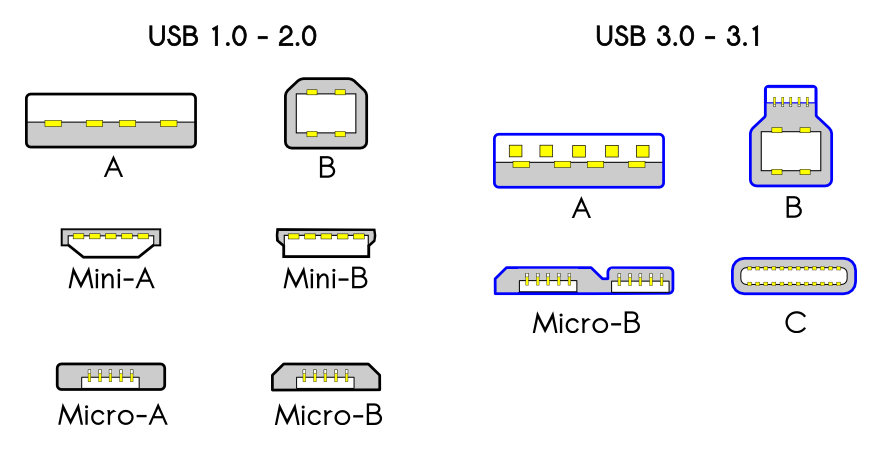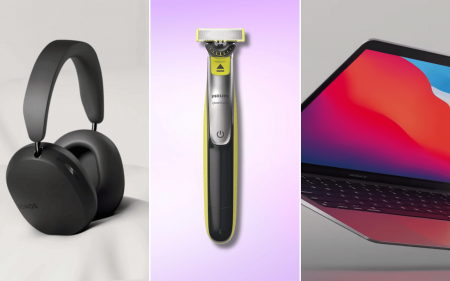The word ‘Universal’ in Universal Serial Bus does about the same work as the word ‘Democratic’ in the Democratic People’s Republic of Korea. That is to say, it’s a lie. The only thing that makes it ‘universal’ is that everyone uses USB, in some form or another, every day. Whether you’re transferring data or charging a device, you’re probably using some form of USB. But where did it come from and why is it so confusing these days?
USB: Origins

USB first came about in 1994 when Intel, Compaq, Microsoft, IBM, Digital Equipment Corporation (DEC), Nortel, and NEC Corporation joined forces. Their goal was to develop a new standard to connect peripheral devices to PCs. One standard to rule them all. The Connector of Power.
Those companies together formed USB Implementers Forum, Inc., a non-profit organisation to oversee the development and implementation of the USB interface. Today, the USB-IF board of directors is made up of people from Apple, HP, Intel, Microsoft, Renesas Electronics, STMicroelectronics, and Texas Instruments.
Fast forward to today and USB is anything but universal. Inconsistent colours, confusing naming schemes, varying transfer and power delivery rates, and different shapes and sizes can make it seem like we’ve gone back to the USB before-times.
See all the pretty colours
It wasn’t always this confusing. Take colours, for example. The first widely used version of USB, USB 1.1 was released in 1998. It was simple, coloured black, and offered transfer speeds of 12 Megabits per second (Mbps). In 2000, USB 2.0 was introduced. It used a white-coloured connector and allowed for speeds of up to 480 Mbps. The 5,000 Mbps capable USB 3.0 was introduced in 2008. It uses a blue connector. 2013 saw the release of USB 3.1, with a green or teal connector. It allows for speeds up to 10,000 Mbps. Finally, USB 3.2 from 2017 uses a red connector and offers transfer speeds of up to 20,000 Mbps.
Those last two are where things started to go south. But it didn’t stop there. You also get USB ports with colours that indicate a specific feature. Some use warmer colours like yellow, orange, or red to indicate fast charging support, that it stays on when the rest of the system shuts down, or which port to use for BIOS updates. This makes it important to know what the USB ports on your motherboard do. The red ones are either… 20Gbps, support fast charging or are for BIOS updates. Good luck.
To make matters worse, some companies have proprietary fast-charging standards and use coloured USB ports to indicate as much. Huawei and Qualcomm are guilty of this. Other companies, like Razer or Cooler Master, use coloured USB ports for aesthetic purposes.
Sometimes change is good
Don’t get us wrong – change is usually good. Like when the standard improves as the technology and needs of the consumer evolve. With that in mind, please, USB-IF, please continue making USBs faster. We wouldn’t even mind a change in shape, if and when the industry necessitates it. But when those changes are made, we don’t think it would be too much trouble to do it in a sensible way. Instead of USB 3.0, 3.1, and 3.2 why not just USB 3, 4, and 5?
 Even if you’ve never noticed or cared about the colour, speed, or version of a USB connector, you can’t ignore the various shapes. Most of the world still uses some form of Type-A connector. That’s the rectangular shape that’s synonymous with USB. You know, the one that’s impossible to insert correctly on your first try. The Type-B connector is the square-looking one sometimes found on printers.
Even if you’ve never noticed or cared about the colour, speed, or version of a USB connector, you can’t ignore the various shapes. Most of the world still uses some form of Type-A connector. That’s the rectangular shape that’s synonymous with USB. You know, the one that’s impossible to insert correctly on your first try. The Type-B connector is the square-looking one sometimes found on printers.
The USB Type-C connector, first introduced in 2014, is the shape the USB-IF is pushing now. That’s the reversible ovular design that most modern smartphones use for their charging ports. Its shape might be reversible but that doesn’t mean you can use USB Type-C ports interchangeably. There’s a popular misconception that all USB Type-C connectors are made equal. Unfortunately, they don’t all always support the same features and can sometimes be slower than their rectangular cousins.
Then there are many other shapes; like the smaller Mini Type-A or B that older smartphones employ or that strange-looking USB Micro B Superspeed connector that external hard drives use. That exists because USB-IF realised they needed more pins to make use of the faster USB 3.0 speeds.
We haven’t even touched on the varying power delivery standards and speeds that most people use USB for. That’ll have to be a separate rant, because there’s a considerable variation in how quickly a port will charge your phone or laptop. The USB-Power Delivery standard can make that easier to understand but even then, that comes in a few flavours, with support in client devices varying.
What does the future hold?
This is why it’s always important to know what your USB-brandishing device can and can’t do. Maybe USB 4 will be the answer to our troubles. The upcoming standard requires, as per the USB-IF, the Type-C connector and support for 20 or 40 Gbps. There’s already some doubt with that ‘or’ but two variations are much better than the current state of the Universal Serial Bus. It’ll probably still be a while before USB 4 is widely adopted but we’ve already seen some cables using the standard. Hopefully, USB can go back to being ‘universal’ in the not-too-distant future.




